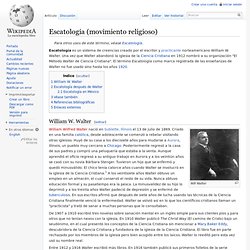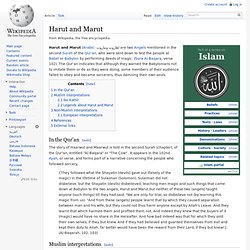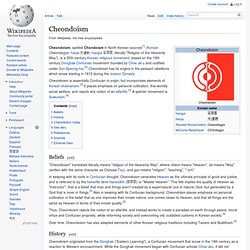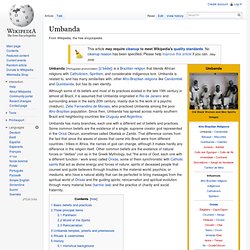

Escatología (movimiento religioso) Escatología es un sistema de creencias creado por el escritor y practicante norteamericano William W.

Walter. Una vez que Walter abandonó la iglesia de la Ciencia Cristiana en 1912 nombró a su organización "El Método Walter de Ciencia Cristiana". El término Escatología como marca registrada de las enseñanzas de Walter no fue usado sino hasta los años 1920. Will Walter William Wilfred Walter nació en Sublette, Illinois el 13 de julio de 1869. De 1907 a 1910 escribió tres novelas sobre sanación mental en un inglés simple para sus clientes píos y para otros que no tenían nexos con la iglesia. Entre 1912 y 1916 Walter escribió más libros. Francmasonería.
La francmasonería o masonería se define a sí misma como una institución discreta de carácter iniciático, no religiosa,[1] filantrópica, simbólica y filosófica fundada en un sentimiento de fraternidad.

Tiene como objetivo la búsqueda de la verdad y fomentar el desarrollo social y moral del ser humano, además del progreso social. [nota 1] Los masones se organizan en estructuras de base denominadas logias, que a su vez pueden estar agrupadas en una organización de ámbito superior normalmente denominada "Gran Logia", "Gran Oriente" o "Gran Priorato". Harut and Marut. Harut and Marut (Arabic: هاروت وماروت) are two Angels mentioned in the second Surah of the Qur'an, who were sent down to test the people at Babel or Babylon by performing deeds of magic.

(Sura Al-Baqara, verse 102). The Qur'an indicates that although they warned the Babylonians not to imitate them or do as they were doing, some members of their audience failed to obey and became sorcerers, thus damning their own souls. In the Qur'an[edit] The story of Haarwut and Maarwut is told in the second Surah (chapter), of the Qur'an, entitled "Al-Baqara" or "The Cow" . La Teoría de Entheogen de la Religión y de la Muerte del Ego. Casero.

Cheondoism. Cheondoism, spelled Chondoism in North Korean sources[1] (Korean Cheondogyo; hanja 天道教; hangul 천도교; literally "Religion of the Heavenly Way"), is a 20th-century Korean religious movement, based on the 19th century Donghak Confucian movement founded by Choe Je-u and codified under Son Byeong-hui.[2] Cheondoism has its origins in the peasant rebellions which arose starting in 1812 during the Joseon Dynasty.

Umbanda. Umbanda (Portuguese pronunciation: [ũˈbɐ̃dɐ]) is a Brazilian religion that blends African religions with Catholicism, Spiritism, and considerable indigenous lore.

Umbanda is related to, and has many similarities with, other Afro-Brazilian religions like Candomblé and Quimbanda, but has its own identity. Although some of its beliefs and most of its practices existed in the late 19th century in almost all Brazil, it is assumed that Umbanda originated in Rio de Janeiro and surrounding areas in the early 20th century, mainly due to the work of a psychic (medium), Zélio Fernandino de Moraes, who practiced Umbanda among the poor Afro-Brazilian population.
Since then, Umbanda has spread across mainly southern Brazil and neighboring countries like Uruguay and Argentina. Umbanda has many branches, each one with a different set of beliefs and practices. Some common beliefs are the existence of a single, supreme creator god represented in the Orixá Olorum, sometimes called Obatalá or Zambi. 1. 2. Scientology. Scientology is a body of beliefs and related practices created by science fiction writer L.

Ron Hubbard (1911–1986), beginning in 1952 as a successor to his earlier self-help system, Dianetics.[6] Hubbard characterized Scientology as a religion, and in 1953 incorporated the Church of Scientology in Camden, New Jersey.[7][8] A large number of organizations overseeing the application of Scientology have been established,[28] the most notable of these being the Church of Scientology. Scientology sponsors a variety of social-service programs.[28][29] These include the Narconon anti-drug program, the Criminon prison rehabilitation program, the Study Tech education methodology, the Volunteer Ministers, the World Institute of Scientology Enterprises, and a set of moral guidelines expressed in a booklet called The Way to Happiness.[30] Scientology is one of the most controversial new religious movements to have arisen in the 20th century.
Etymology and earlier usage History Dianetics L. Abraham ibn Ezra. Rabbi Abraham Ben Meir Ibn Ezra (Hebrew: אברהם אבן עזרא or ראב"ע, Arabic ابن عزرا; also known as Abenezra) (1089–1164) was born at Tudela, Navarre (now in Spain[1]) in 1089,[2] and died c. 1167, apparently in Calahorra.[3] He was one of the most distinguished Jewish men of letters and writers of the Middle Ages.

Ibn Ezra excelled in philosophy, astronomy/astrology, mathematics, poetry, linguistics, and exegesis; he was called The Wise, The Great and The Admirable Doctor. He was born at Tudela,[citation needed] (in the present-day province of Navarre) when the town was under the Muslim rule of the emirs of Zaragoza. Later he lived in Córdoba. In Granada, it is said, he met his future friend (and perhaps his father-in-law) Yehuda Halevi. He left Spain before 1140 to escape persecution of the Jews by the new fanatical regime of the Almohads.
Works[edit] The Book Exodus with the commentary of Abraham ibn Ezra,Naples 1488 Ibn Ezra also wrote a commentary on the book of Ecclesiastes.